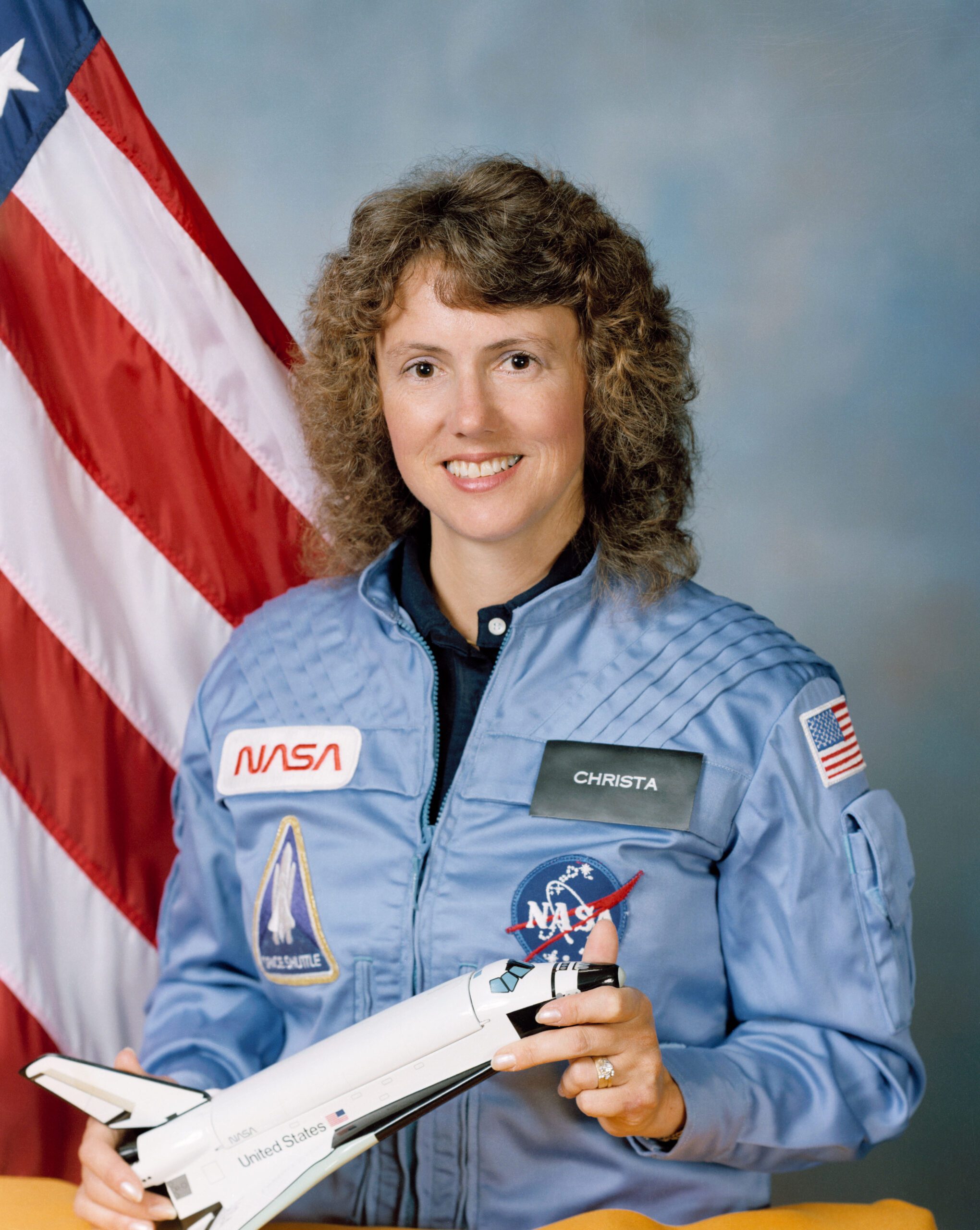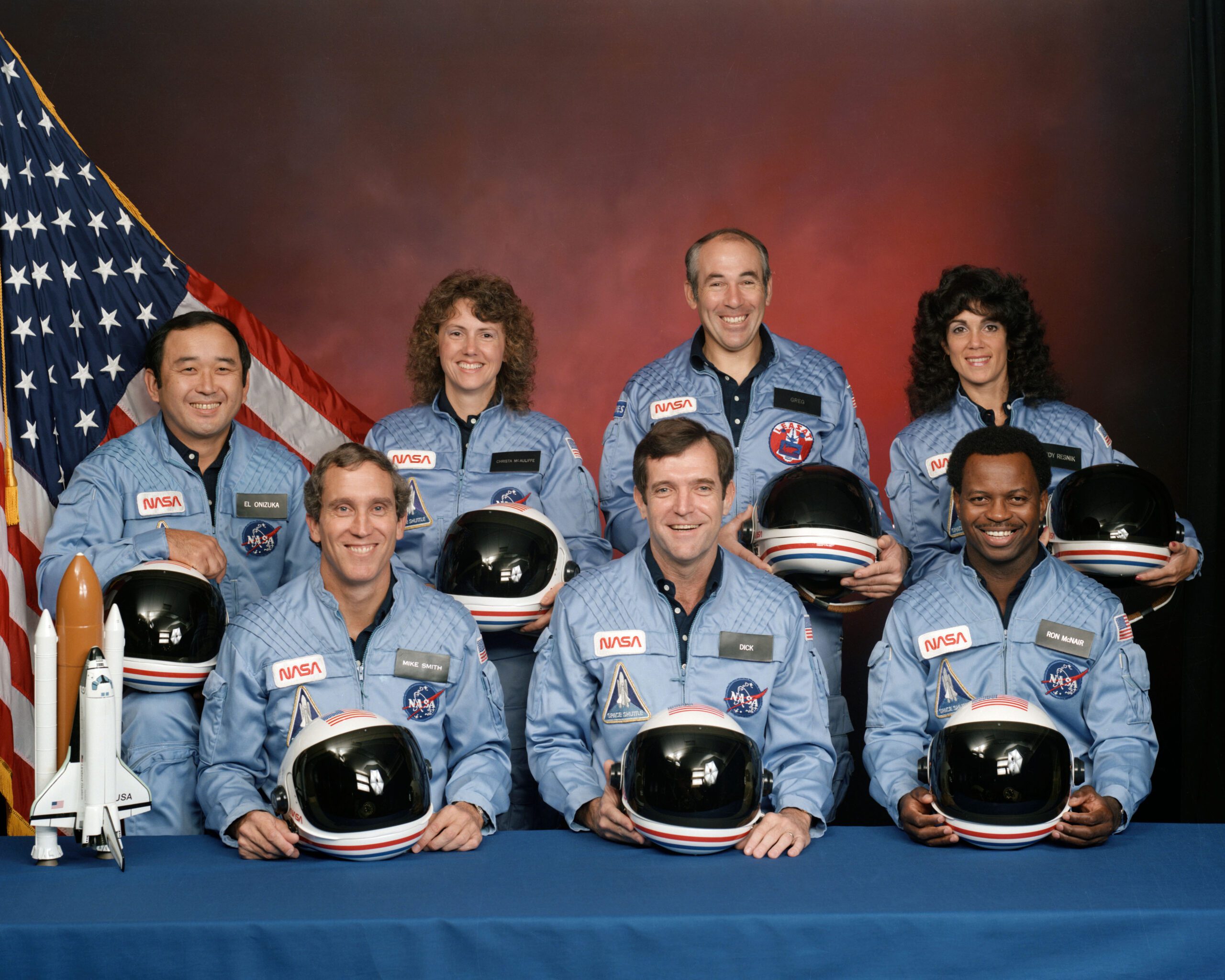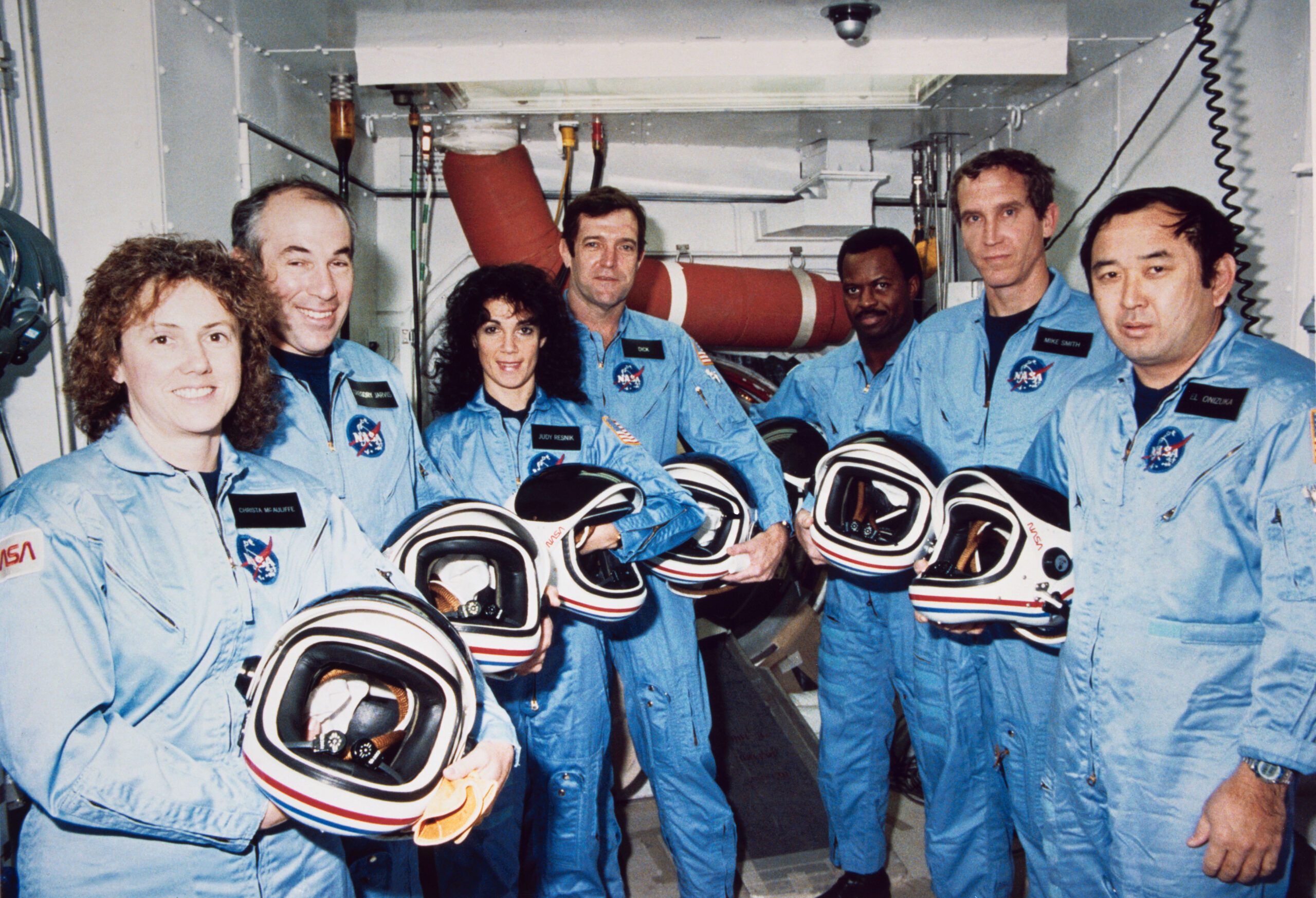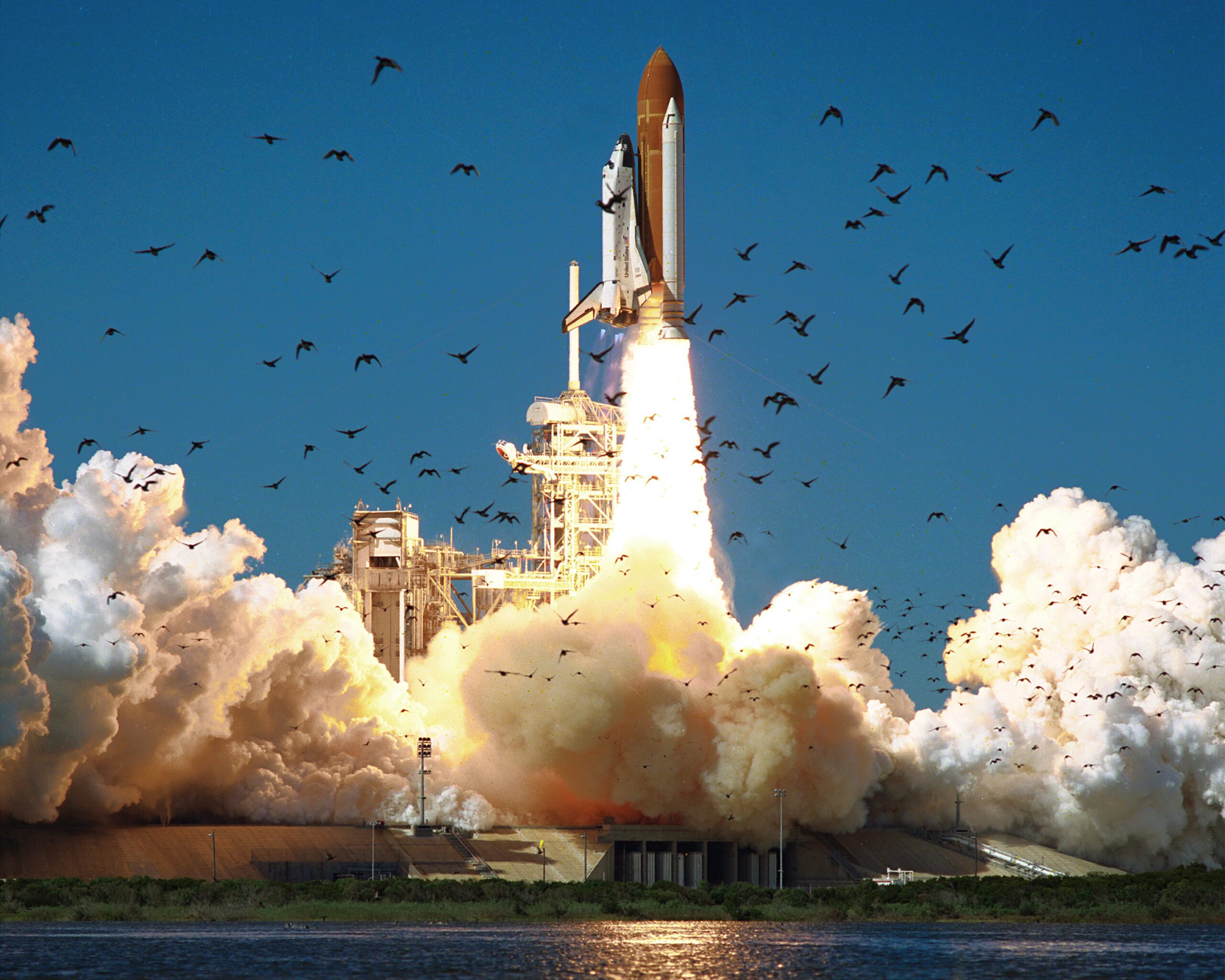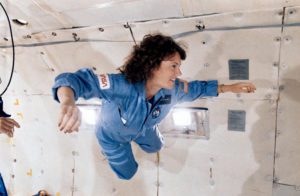
“I watched the Space Age being born and I would like to participate.”
– from Christa McAuliffe’s NASA application
On the day NASA selected Christa McAuliffe for the Teacher in Space Program—a half earnest, poorly managed publicity stunt meant to spur dwindling interest in the space program—she and the nine runners up had already been told McAuliffe was the winner. NASA wanted the spectacle, and so they paraded her in front of reporters in the Roosevelt Room, handing her a trophy that might have been a sash.
Christa, how does it feel to be picked?
“I’m still kind of floating. I don’t know when I’ll come back down to earth.”
For me, it all started with a photograph of Christa during her zero-gravity training, which I discovered for the first time on the thirtieth anniversary of the Challenger disaster. In the photo, Christa is floating alone in the frame with nothing and no one behind her but the white interior of a KC-135 Stratotanker aircraft and the sunlight streaking in through a single small window. In the photograph, she looks elated, amateurish, destined for weightlessness. Even though the photo was new to me, it felt like I had seen it a hundred times before, and maybe I had but never paid attention. The Challenger disaster happened two years before I was born, and, as I looked longer at Christa’s sidelong gaze, I felt the creeping warmth of a memory inherited.
Dear Admiral Truly:
The search for wreckage of the Challenger crew cabin has been completed. A team of engineers and scientists has analyzed the wreckage and all other available evidence in an attempt to determine the cause of death of the Challenger crew. This letter is to report to you on the results of this effort. The findings are inconclusive. The impact of the crew compartment with the ocean surface was so violent that evidence of damage occurring in the seconds which followed the explosion was masked. Our final conclusions are:
- the cause of death of the Challenger astronauts cannot be positively determined;
- the forces to which the crew were exposed during Orbiter breakup were probably not sufficient to cause death or serious injury; and
- the crew possibly, but not certainly, lost consciousness in the seconds following Orbiter breakup due to in-flight loss of crew module pressure.
Christa was one out of 11,000 teachers who applied to the Teacher in Space program. As a teacher, she designed a high-school history course, where she set to prove the ways common people could be remembered throughout history. She called it “The American Woman.”
One time, Christa invited a suicidal student to her house. The two talked late into the evening until she put the girl to bed in her son Scott’s room. Christa stayed up all night watching over her. Another time, Christa took her class on a field trip to a women’s prison, where her students met with a woman who was serving eight to twelve years for hiding her boyfriend’s drugs. The lesson was in human frailty.
Her favorite show was Superman.
Her favorite song was “Leaving on a Jet Plane.”
Christa and her husband’s love was admirable in an almost fictional way, the kind of love story you don’t think exists anymore: the kind where the boys, including Stephen McAuliffe, her future husband, whisper to one another about how lovely the new girl is as she walks into class; the kind of love story with glances and shy smiles across a homeroom class; the love-at-first-sight kind of love.
The day before the Challenger disaster, Steve McAuliffe told a reporter that the saddest day of his life was when he was ten and his dog died.
The accident happened at 48,000 feet, and the crew cabin was at that altitude or higher for almost a minute. At that altitude, without an oxygen supply, loss of cabin pressure would have caused rapid loss of consciousness and it would not have been regained before water impact.
These are the items that Christa took on the Challenger shuttle for launch STS-51-L:
- Her husband Steve’s class ring.
- A cross and chain for her daughter Caroline.
- A ring for her sister Lisa.
- Two military pins belonging to Steve’s brothers, Wayne and David.
- A Girl Scout Pin.
- A watch given to her by her grandmother.
- A poem written by a WWII combat pilot.
- Several miniature flags to be given to New Hampshire schools.
- A portable cassette player with tapes from Carly Simon, Bob Dylan, and James Galway.
- Her son Scott’s stuffed frog, named Fleegle, vacuum packed to fit with the rest of the luggage.
- A pair of gold earrings Steve had surprised her with for Christmas that year. They were shaped like little apples.
During the FBI background check, Christa’s friends and coworkers were frustrated by the Cold-War era questions they were being asked by the investigator, and they even questioned the whole necessity of the investigation. “She’s your basic ordinary person who happens to be in extraordinary circumstances,” said Anne Malavich, one of Christa’s closest friends.
In reading testimonies like this, I became annoyed by the fast-and-loose use of “ordinary” as a compliment towards Christa, even when she used the term to describe herself. Perhaps her “ordinariness” is the reason she was such an attractive pick for the Teacher in Space program, but I think Christa’s definition of ordinary is different than the version people use when describing her, especially Malavich’s. When Christa uses “ordinary” to refer to people, she means people in ordinary circumstances—the housewife, the kitchen, the two kids, the frozen meals, the suburbs, the Kraft mac and cheese, the former Girl Scout, the teacher—who, despite those circumstances, are able to be extraordinary. Christa told a reporter that if she had lived in the 17th century she would have ridden on the Mayflower. If she had lived in the 19th century she would have ridden in Conestoga wagons.
Christa was an extraordinary person located in an ordinary existence, until she became an ordinary person in an extraordinary occupation—astronaut. Space People. Rocket Riders.
Ellison Onizuka: Flight Test Instructor for the US Airforce Test Pilot School. 74 hours spent in orbit.
Judy Resnik: NASA engineer and second American woman to travel to space. 145 hours spent in orbit.
Ron McNair: Laser physicist. 191 hours spent in orbit.
Dick Scobee: Air Force Test Pilot, Combat Aviator, and Vietnam Veteran. 167 hours spent in orbit.
Christa’s death resonates with me in a way the others don’t, because like the American Woman she taught about, she represented an extraordinary person taken out of her ordinary circumstances and put into extraordinary ones. And as the world found out on January 28, 1986, an extraordinary circumstance can also be an unimaginable tragedy.
“She has a good idea of who she is, and what she sees is pretty good. That’s very unusual today. I know this doesn’t sound very scientific, but I think she’s neat.”
– Dr. Terrence McGuire, NASA’s consulting psychiatrist
In simulated Zero G, she looks like a natural, except for those nails painted red and the silver wrist watch that probably wouldn’t work in space anyway. Maybe she knew the photo would become iconic so she flashed that winning smile. With the white backdrop and sun just shining through the window, she looked so ethereal, nothing at all like the darkness of space.
In a different picture, Christa is standing in profile, black and white. Above her right hip one can see the Teacher in Space patch, which shows a shuttle’s ascension through the eternal flame of knowledge.
Christa, when asked by fellow astronaut, Ronald McNair, whether she can continue to make a bigger impact beyond this mission: “I’m not sure, but I can’t wait to find out.”
Christa on the malfunction of the Columbia shuttle orbit: “Sure, they went to a lower orbit, but the point is that they were able to do that. Just think of those early astronauts in those capsules who had no buttons to push. They had no control over their destiny if something went wrong. Today’s program is a very safe program, so I’m not nervous. I’d just like them to get all the kinks out of it before I get in it.”
Christa on how she plans to keep her newfound fame in perspective: “I have thirty-six exciting years behind me and thirty-six more ahead of me. It’s not like I’m never going to get back to Earth again.”
PEAP activation could have been an instinctive response to unexpected loss of cabin pressure. If a leak developed in the crew compartment as a result of structural damage during or after breakup (even if the PEAP’s had been activated), the breathing air available would not have prevented rapid loss of consciousness.
The crew seats and restraint harnesses showed patterns of failure which demonstrates that all the seats were in place and occupied at water impact with all harnesses locked. This would likely be the case had rapid loss of consciousness occurred, but it does not constitute proof.
“I literally stared at that photo for months playing guitar,” said Chris Alfieri, a member of the black metal band Vattnet Viskar. He was referring to the iconic picture of Christa taken during her Zero-G training. “She looks so alive and glowing. It’s one of the most conflicted things I’ve ever seen: to be so happy, at the peak of life, only to have it all gone right after.”
The band’s second full-length album Settler is dedicated to the life and death of Christa, and on the song “Impact” Alfieri growls, in a typical black metal timbre:
I sleep when I hit the sea. / A child unaware / a family standing in awe. / I look back and wonder / “what happened here?” / Now I rain upon you; / Now I rest upon a pillar of smoke.
Between the blast beats and electric guitars, there is less rage than one would expect from a metal outfit, and instead a sense of frustrated confusion—more asking why. In songs like “Yearn,” we get just that—a yearning to understand the line between happiness and death, with lyrics like “Eat the light / wither and die / we reach for the sun / and we fall.” Alfieri, who is also from McAuliffe’s hometown of Concord, New Hampshire, mentions that the Challenger Disaster is one of his first memories, and I can see how this album is an attempt to understand American gravity.
The band recreated the iconic Zero-G photo for their album cover, another move that makes them unique in their genre—far from the gloomy, dark, harbinger-ridden cover art typical of metal albums. That doesn’t mean the album cover doesn’t carry a similar uneasiness. The modern-day model the band chose for the cover photo accurately portrays Christa’s awkwardly posed weightlessness, but can’t replicate her smile. What the cover captures is the attention to the ethereal whiteness that surrounds McAuliffe in the original photo, which isn’t doctored like it is on the album cover, but still creates a sense of tired wakefulness. In Alfieri’s description of the cover art, he says:
At first glance, the astronaut’s smile and weightlessness convey delight, a fearless look into the beyond. The points of light [adds] to its overall joy, but there’s darkness behind it and sadness so profound we as Americans have willfully placed it in the darkest corners of our collective conscience.
When I think about the first time I saw the image and its feelings of familiarity, I can see how the picture might exist in a kind of collective subconscious that cannot juxtapose the joy of this person against a backdrop of unholy whiteness. Like with the original image of Christa, Settler’s album cover and the post-metal melodies within it are unsettling and beautiful.
From the final lines of the album’s last track, “Glory:” “It’s hard to see what you’ve become / but you’ll always be so beautiful to me.”
As I watch these training videos of Christa, I feel a graveness similar to the time I watched Rebel without a Cause, knowing that James Dean died twenty-seven days before the movie hit theaters. It feels like I am watching a ghost. It is an odd sensation, watching someone do their job and knowing they are going to die—a kind of dramatic irony where the audience knows something the players don’t. They are test videos, filmed on this planet, where McAuliffe is running through the educational lessons she will eventually be giving from space. She is unscripted because there is no script, a battle she fought with NASA. She argued that the classroom isn’t a stage, and teaching isn’t a play: “It’s worked for ages on Earth, and there’s no reason why it shouldn’t work up there.” And she was right. Even in these premature runs, she controls the room, tossing out orders to the camera crew and her fellow crew mates on where to stand, what to zoom in on. At some point during the fake filming, she accidentally drops something off of a shelf, and, feigning with her hand over her head, says, “Oh, this zero gravity is just awful,” as if she were taking ownership of her fumble in front of a room of students.
At the dawn of the Teacher in Space program, the New York Times wrote:
The media malarkey in which this master teacher would be draped would turn a good schoolteacher into another useless celebrity adept at breakfast-time chatter with David Hartman and June Pauley, but too world weary to pound the desk effectively at a slovenly student’s misreading of Caesar… This would be a sad end for a good teacher.
But that isn’t the case in these videos, which were filmed a long time after the trophy-wielding publicity stunt in the Roosevelt Room. She is a natural at what she does, and knowing this will be the last time she gets to do it only makes it more obvious. It shows that maybe she is, authentically, 1 in 11,000.
During the downtime from their training, Christa was known to play Trivial Pursuit with runner-up pick Barbara Morgan and Payload Specialist Greg Jarvis. “Who knows” Christa joked, “maybe one of us will end up a trivia question one day.”
From the twentieth anniversary edition of Trivial Pursuit: Who predicted Mission 51-L, the 25th space shuttle flight, would be “the ultimate field trip?” Answer: Christa McAuliffe.
I decided to visit her grave, but I’m not sure why; maybe because it is close to where I live, maybe because I was looking for some inspiration or some reason to feel sad, or maybe to pay my respects to a woman who, in the way it happens when you write about someone for a long period of time, has started to feel like family. I didn’t make it. Forgetting it was also Memorial Day, my car broke down after sitting in ninety-degree traffic for too long, half a mile outside Arlington National Cemetery.
“It’s crazy that these people think their loved ones in the ground give a shit about whether or not it’s Memorial Day,” the tow truck driver commented as he loaded my car onto the truck bed. “If they care at all,” he continued. I wonder if he knew that’s where I was headed, to do maybe the same thing, except to a grave I knew to be empty. I would have been paying my respects to a stone, which is maybe about as laughable as this AAA guy made it seem. Maybe.
As we hauled my car to the garage, the guy pointed out various busty women out for a midday jog, commenting on whether or not their sports bras were doing the job they were designed for. Christa fought her entire life for feminism, and it pains me to think that this kind of banter is still common thirty years after her death. If she were with us, she probably would have said something, told him off or said something condescending, like I should have. Instead, I false-chuckled between saying, “I know, right?” while wanting to say, “I’m sorry, Christa”—to apologize for him, to apologize for me, to apologize for the lack of progress we’ve made since she died. I wanted to say I was sorry, even if it was to a grave I knew to be empty.
Beyond Christa’s extended family, these are the people who were in attendance on January 22 at the launch of STS-51-L: 15,000 special guests including…
- Vice President George Bush
- One Senator
- Two representatives from Florida
- One Governor
- One Moroccan ambassador to the US
- A delegation from the People Republic of China
- The president of the National Education Association
- The president of the American Federation of Teachers
- Christa’s son Scott’s entire third grade class
- The city of Concord school board members, governor, union leaders, police chief, and superintendent (with his daughter)
- The editor of Concord High’s school paper
- Former colleagues from when Christa taught in Maryland
- Several long-term friends from Christa’s Girl Scout troop
- The class of 51-L, including the nine Runners up for the Teacher in Space program and backup Barbara Morgan
Of course, this isn’t completely true, because the flight was delayed to the next day, due to delays in an earlier mission. This meant that the Vice President would no longer be able to attend. Then the flight was delayed again to the next day due to cold weather. Then the next, and the next after that, until, ultimately, the flight was cleared for launch on January 28, six days after its original launch date. Thousands from the original flight had to return to their own lives, including much of the class of 51-L. Scott’s third grade class remained.
Even though only a fraction of the people expected to be present for the launch were able to stay the full six days, millions across the nation were able to tune in to watch Christa McAuliffe, the first civilian to fly into space, fly into space. Five miles away from the launch site, a teacher turned on the local news and told her class they were about to watch a scene from Star Wars.
A year after my car broke down outside of Arlington Cemetery, I was visiting friends in Orlando over Memorial Day Weekend. We took a trip a trip to Kennedy Space Center, and, while my friends went to stand in line for the take-off simulator I knew my notorious motion sickness wouldn’t endure, I wandered off alone to the Memorial Space Mirror, dedicated to those who have died in service to US space programs.
The long walk to the mirror is shadeless, open, and empty. When you arrive up the path to face the face of the mirror, the summer heat, reflected, becomes blinding and nearly unbearable. Carved into the mirror are the eroded names to whom the memorial is dedicated—mostly the crews of the Challenger and Columbia disasters. Whoever designed the memorial was either pessimistic or realistic, leaving plenty of room amidst the small handful of names for future additions. At the top of the mirror, barbs have been installed to discourage nesting, while overhead, grackles and other small birds circle about, searching for a place to touch down.
Not another soul in sight, I reflected beside the reflecting mirror for a few minutes before leaving to seek out some shade, slipping a $5 bill into the memorial fund donation box.
Christa’s last known words were, “Hope so, too,” which she said over the Challenger intercom regarding her eagerness to take off after six days of false starts, some of which the crew had to wait for hours in position waiting to find out whether the plug would be pulled. These aren’t the last words I care about though. Before she boarded the shuttle on January 28, she hugged her family goodbye for the sixth and final time and, finally, to her daughter said, “Okay, honey, I have to go now. I’ll see you later, alligator.”
Six dry runs are enough runs to start feeling ritual, which is maybe why these are the last words that give the most closure. If the flight had taken off a week earlier, her last words might have been something more heartfelt and more ordinary in affectation, but “See you later, alligator” is heartbreaking in its ordinariness, the same ordinariness I slandered earlier. They are the last words of a taxi driver the morning before he starts his daily shift or the veteran boxer about to fight. They don’t show any anxiety or overzealousness. Just the simple goodbye of a person about to do the job they were meant for. See you later, alligator.
At 48,000 feet, you might have felt the explosion of the shuttle shattering into seven pieces, or might have heard pilot Michael Smith’s “Uh oh” over the intercom, the last transmission ever received from the Challenger, but you wouldn’t have seen it happen. You and McNair would have been on the lower deck, the crew cabin, next to the beds and the lockers where Fleegle, removed of his stuffing, was stuffed. You would have been harnessed to the specialist’s seat and out of sight of any windows that might have been trying to blind you with their ethereal whiteness.
On the level above, Judy Resnick and Ellison Onizuka would be hurriedly activating their Personal Egress Air Packs (PEAPs) and that of Smith’s, who would be seated directly in front of them and would be fiddling with the panel switches to his right, trying anything at this point to get the power back on while the cockpit ascends to 65,000 feet. Meanwhile, Dick Scobee, the flight’s commander, would be doing exactly what the lead investigator of disaster in its aftermath said he would do: “Everything he could to save his crew.”
Separated from the rest of your crew, you wouldn’t know if something had happened. McNair might have—this wasn’t his first mission—and the two of you might have activated your PEAPs, giving you six minutes of air to survive the near-three minutes of ascension and free-fall following the breakup.
But unlike the three above deck, there is no evidence that shows whether you activated your PEAP in time, and even if you had, the change in pressure seconds after the explosion would have caused you and the entire crew to fall unconscious either way. You would have heard “Uh oh,” and that’s it. You wouldn’t have had time to feel scared or lose confidence or think about death. You wouldn’t have had enough time for your life to flash before your eyes.
At 48,000 feet, you would have been alive but unconscious when the shuttle shattered into seven pieces. After the explosion, the cockpit with you in it would be hurled higher, finally peaking at 65,000 feet where, for one second—just one second exactly—you would have floated. An American woman. In the next two minutes and forty-five seconds of freefall, you would reach a terminal velocity of 204 miles per hour until, finally, you came back down to earth.
***
Image credits: feature image, image 1, image 2, image 3, image 4.
***
Works Cited:
Hohler, Robert. I Touch the Future: The Story of Christa McAuliffe. Random House, 1986.
Mullane, Mike. Riding Rockets: The Outrageous Tales of a Space Shuttle Astronaut. Scribner, 2006.
“Christa’s Lost Lessons.” Challenger.org

